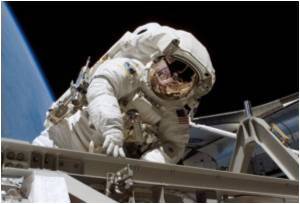
"We're able to provide a wide variety of products in thermal-stabilized or freeze-dried form. And we can provide some in natural form, such as cookies or crackers," Discovery News quoted Kloeris, who manages food systems for both U.S. shuttle and International Space Station (ISS) missions, as saying.
Far from flavourless cubes, the menu selection includes such astronaut favourites as shrimp cocktail.
The shrimp come freeze-dried, and the spicy cocktail sauce arrives as a powder. All you have to do is add some water.
The preservation process doesn't work for every food item. And Kloeris said that acceptable space pizza continues to elude NASA.
Yet an astronaut aboard the ISS still has roughly 180 foods and beverages to choose from-and that's just the American menu.
Advertisement
Other than some occasional requests for a particular blend of coffee, there's very little ordering off the menu.
Advertisement
"Most of our vegetarians have flown on the shuttle, so if we send a vegetarian crew member up for six months in orbit, that's going to be a challenge. Especially because half the food systems come from the Russian side, and I can tell you there is very little vegetarian [fare] on the Russian menu," said Kloeris.
ISS crew members also get to stash a few "preference items" away, enough to equal 1 cubic foot of storage space for every month they are in orbit.
However, there is reason why all this space food is either dried-out or heat-treated.
First, NASA demands a pretty high shelf life for its groceries- two years for most freeze-dried foods and three years for thermo-stabilized foods.
And secondly, there is only so much room aboard the resupply missions.
"[Transport] to the International Space Station is a very precious commodity. We're launching food on the shuttle and will continue to do that until the shuttle retires, but we are also sending food to Russia to launch on the Progress, to South America to launch on the European Space Agency (ESA)'s Automated Transfer Vehicle (ATV) and to Japan to launch on the H-II Transfer Vehicle (HTV)," said Kloeris.
Dehydrated foods offer a particular value as the ISS's newest dehydration station uses recycled water from the rest of the station.
"It takes a lot of packaging to get the kind of shelf life we need on these products. Plus the crew members really want the items to be packaged in single servings. They don't want to have to deal with opening and re-closing things because it's difficult to deal with bulk storage in microgravity," said Kloeris.
NASA emphasizes nutritious space food and, luckily, human nutritional requirements in space are pretty much the same as they are on Earth, with a few small exceptions.
"NASA has discovered some things about nutrition that are slightly different in space. For instance, you don't need as much iron because you're not turning over red blood cells as frequently in microgravity as you would on the ground," said Kloeris.
Source-ANI








